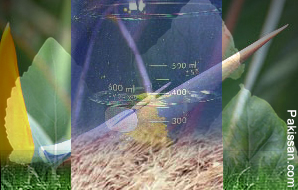|
Potassium and its role in crop growth
Dr. S.M. Alam
Dr. M.H. Naqvi
Potassium as an essential element is the backbone to a plant's life and it plays many vital roles in its nutrition. It increases root growth, improves drought resistance, enhances several enzyme functions , builds cellulose, reduces lodging, controls plant turgidity, maintains the selectivity and integrity of the cell membranes, helps translocation of sugars and starch, reduces water loss and wilting, reduces respiration, prevents energy losses, helps in protein synthesis and uplifts the protein content of plants, produces grain rich in starch and controls plants' diseases.
Ionic form: Potassium is an abundant element, ranking seventh among all the elements in the earth's crust, 2.59 per cent of which is
potassium in combined form. Plant readily absorbs available soil potassium. It is highly mobile within plant tissues. It moves readily from the lower to the upper and younger plant tissues and that is why deficiency symptoms of potassium appear on older leaves first. A large part of plant potassium can be in found cell sap in soluble form. Unlike nitrogen and phosphorus and most other essential nutrients, potassium does not become an integral part of the chemical structure of the plant.
Potassium is an essential element for plant growth and reproduction. Usually it is present in plants in quantities larger than any of the
other nutrients except nitrogen. Some plant tissues accumulate relatively large concentrations of potassium from the growth medium.
It plays many important regulatory roles in biochemical and physiological functions of plant growth, although it does not become a part of the chemical structure of plants.
Enzyme activation: Potassium has a major role in plant metabolism as it activates several enzymes especially in the metabolization of
carbohydrates. The specific and positive role of enzyme activation is probably one of the most important functions of potassium in plant
growth. Potassium in elemental form is generally required to energize at least 60 different enzymes, which take part in plant growth. It is
required for the synthesis of proteins, for the metabolism of carbohydrates, and lipids and is an activator of numerous enzymes.
Potassium synthesis: Protein synthesis is especially dependent on potassium at several stages of amino acids activation. Transport of
amino acids to the sites of protein synthesis act of enzyme syndrome and balancing of electrical charges are among the key roles of
potassium. Potassium is potentially required for every major steps of protein synthesis.
It plays a potential role in the transport of water and essential nutrient throughout the plant in the xylem. When supply of potassium
is abated, the uptake of calcium, magnesium, nitrates, phosphates, manganese and amino acid is very much depressed. Theaccumulation of potassium in plant roots produces a gradient of osmotic pressure that draws water into the roots. Plantsdeficient in potassium are less able to absorb water and more subject to stress when water is in short supply. Potassium is involved in regulating the smooth movement of water into and out of stomatas.
Plants also depend upon potassium to regulate the opening and closing of stomata (the pores through which leaves exchange carbon dioxide, water, vapour oxygen with the atmosphere). If potassium supply is inadequate, the stomata become sluggish slow to respond and water vapour is lost.
The enzyme responsible for synthesis of starch in leaves is activated by potassium. Under high potassium levels starch is used more
effectively because of its transfer from stems to storage organs and other plants. Potassium deficiency: Potassium deficiency decreases root elongation and root thickness, which will affect the absorption of other nutrient elements. When potassium is deficient, some plants produce large cocentrations of the basic amine putrescine. Because potassium is mobile in the plant, when deficient, it moves from older leaves which are, therefore, usually the first to show symptoms of deficiency. Initially, the leaf margins display a rusty or bronze colour and later shrivel. Eventually, the whole leaf dries out and is sheded, the terminal bud dies. Such deficiencies are likely to occur in highly weathered coarse textured soils in humid areas. Such soils are low in potassium reserves, have a low cation exchange capacity and are leached readily under heavy rainfall.
Excess potassium: Excess application of potassium generally includes increased risk of magnesium deficiency in susceptible crops and
damage to germination by osmotic effects. Both inhibitory as well as stimulatory effects of salt stress on the concentration of potassium
have been reported on different crops. Salinity and potassium: Potassium, which is an essential cytoplasmic element because of its involvement in osmotic regulation and its competitive effect against sodium, is frequently considered important under saline conditions.
Increased sodium growth medium generally decreased the potassium content, however suggesting an antagonism between sodium and
potassium. Potassium not only participates in osmotic adjustment under saline conditions but also participates in
turgor-mediated response such as stomatal and leaf movement. The salt tolerance capacity of plants depends on the efficiency of the potassium uptake mechanism.
Sindh's soil: The soils of Sindh are alluvial and calcareous in nature and alkaline in reaction. The soils contain enough potassium for normal growth of plants. Its application is seldom necessary. The total potassium content varies from 0.5 to 1.5 percent. Its available
concentration in soil generally varies from 250 to 600 ppm. This indicates that the soils of Sindh are rich in available potassium.
Crop quality: Generally, high levels of available potassium improve the physical quality, disease resistance, tolerance of water stress,
rate of grain development, winter hardiness, feeding value of grain and forage crops. Quality is becoming an increasingly important market factor, so adequate potassium will become more critical for the value of the crop produced.
|
Pakissan.com;
|